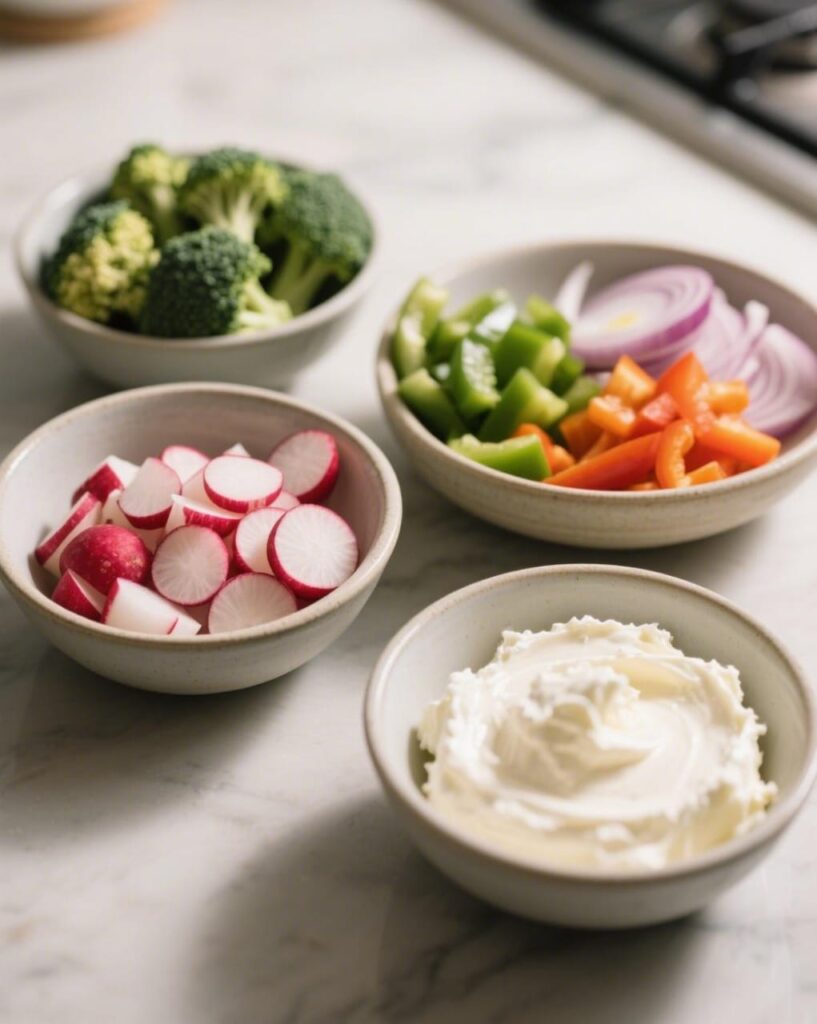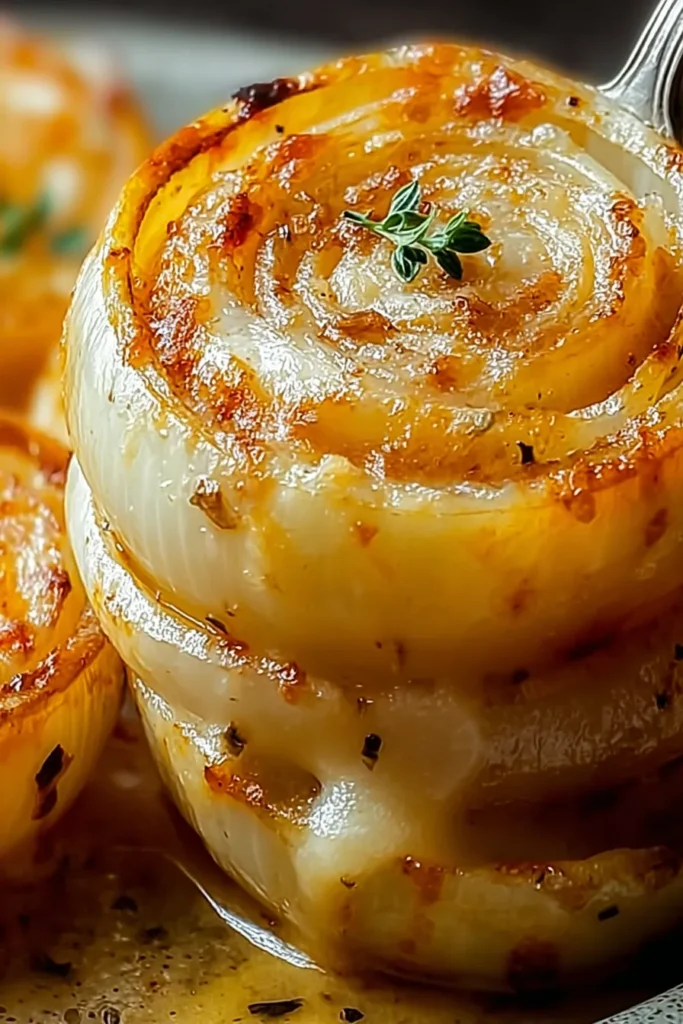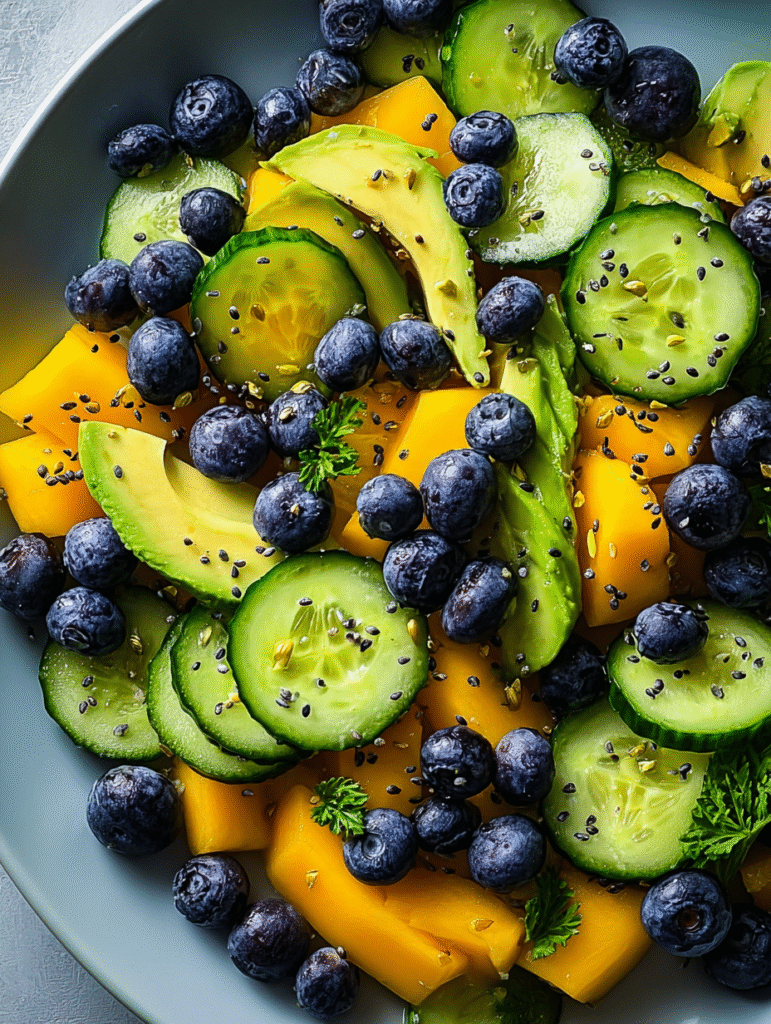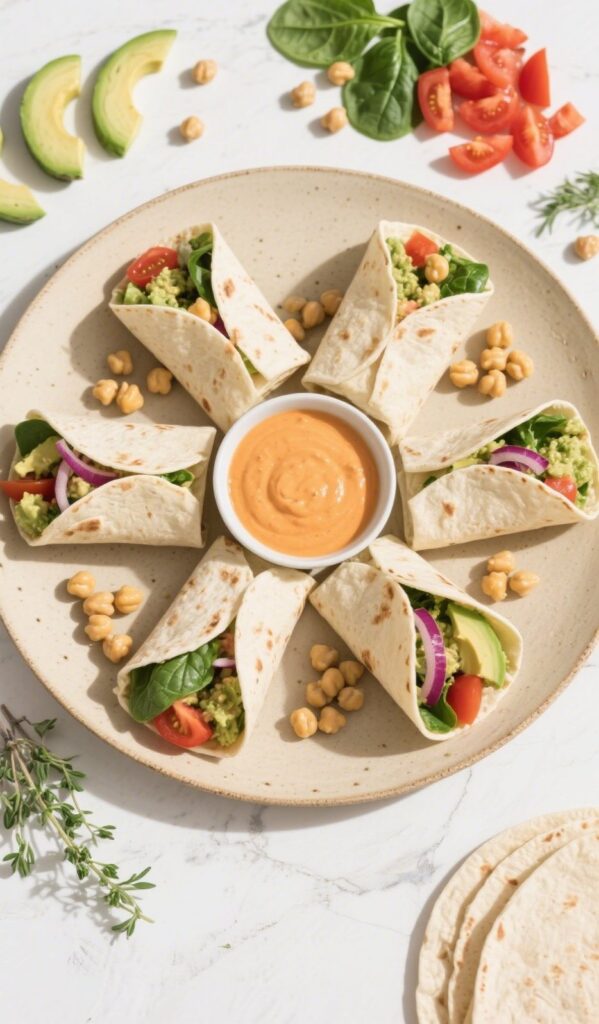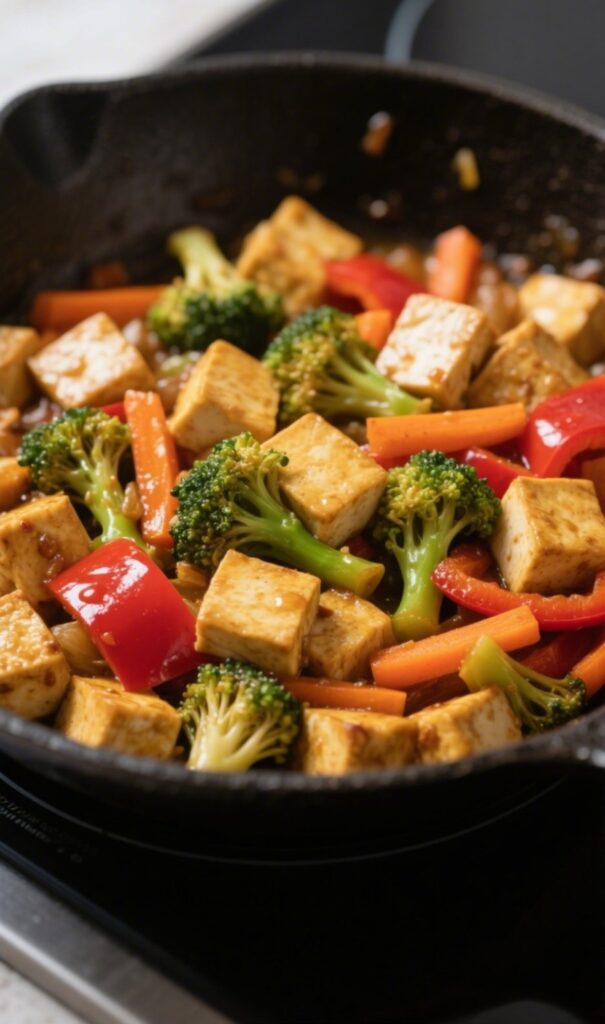Veggie Pizza: The Ultimate Guide to a Flavorful, Nutritious Slice

Craving pizza without the guilt? Look no further than veggie pizza. This wholesome alternative to traditional pies delivers big on taste, nutrition, and satisfaction. In this guide, we’ll uncover everything you need to know about veggie pizza — from its nutritional benefits to topping ideas, cooking methods, and a simple yet mouthwatering recipe. Whether you’re a health-conscious eater, a vegetarian, or just love colorful meals, this article is your one-stop shop.
Don’t miss our Homemade Veggie Pizza: A Slice of Sunshine for another fantastic take on this delicious dish.
Nutritional Power of Veggie Pizza
What Makes Veggie Pizza a Healthy Choice?
Veggie pizza stands out as a healthier alternative to its meat-heavy counterparts. Thanks to a generous serving of vegetables, it’s rich in fiber, vitamins, and antioxidants. The base—often made from whole wheat, cauliflower, or even crescent rolls—can reduce refined carb intake.
Vegetables like broccoli, peppers, carrots, and onions deliver:
- Vitamin A, C, and K
- Folate and iron
- High fiber to improve digestion
- Phytonutrients for immune support
Add that to a light cream cheese or tomato base, and you’ve got a balanced blend of taste and health.
Comparing Veggie Pizza to Meat-Based Pizzas
When compared to meat-loaded options, veggie pizza has:
| Component | Veggie Pizza (per slice) | Meat Pizza (per slice) |
|---|---|---|
| Calories | ~196 | ~280–350 |
| Fat | ~13g | ~18–22g |
| Carbohydrates | ~16g | ~25–35g |
| Protein | ~5g | ~10–15g |
| Fiber | Higher | Lower |
Veggie pizza generally contains fewer calories and saturated fats, which supports heart health and weight management.
How Carbohydrates Fit Into the Equation
Yes, veggie pizza has carbs — about 16 grams per slice when using a crescent roll crust. However, these carbs serve as a quick energy source, especially when paired with fiber-rich vegetables and healthy fats from cream cheese. This balance helps prevent blood sugar spikes and crashes, making it a suitable option even for those watching their intake.
Looking for inspiration? Try our Gluten-Free Chickpea Pasta Salad for a similarly balanced meal idea.
The Role of Cheese and Sauce in Health Balance
The cream cheese and sour cream mixture commonly used in veggie pizza creates a creamy base rich in calcium and flavor. Adding herbs like dill and garlic powder instead of high-sodium sauces keeps the dish flavorful without excessive salt.
Keep portions moderate and use reduced-fat dairy options if you’re watching calories or cholesterol.
Building the Perfect Veggie Pizza Base
Choosing the Right Crust for Your Vegetable Pizza
The foundation of every delicious pizza is the crust, and when it comes to veggie-focused pies, the choice of base makes a big difference in both taste and nutrition. Whether you’re going classic or experimenting, here are some great options:
| Crust Type | Features | Nutrition Benefit |
|---|---|---|
| Crescent Roll Dough | Buttery and soft | Lower in fiber, great for kids |
| Whole Wheat Crust | Earthy flavor, hearty texture | Rich in fiber and B vitamins |
| Cauliflower Crust | Gluten-free, grain-free option | Lower in carbs, veggie-packed |
| Thin-Crust Flatbread | Crispy and light | Fewer calories, perfect for layering |
In our featured recipe, we use crescent rolls for convenience and taste—ideal for potlucks or quick family dinners.
Discover great ideas like Mini Cheesy Veggie Bites if you’re into bite-sized versions.
Sauce and Spread: From Ranch Mix to Herb-Infused Cream Cheese
Instead of traditional tomato sauce, our recipe uses a blend of sour cream, cream cheese, and ranch seasoning. This creamy spread is seasoned with:
- Dill weed – Adds a fresh, herby punch
- Garlic salt – Enhances flavor subtly
- Ranch mix – Offers tang and depth
This spread acts as a flavorful glue for all the chopped vegetables, making every bite taste indulgent yet balanced.
If you’re going for a lighter variation, substitute sour cream with Greek yogurt or try hummus for a Mediterranean twist.
Prepping the Base Like a Pro
Once your dough is pressed into the baking sheet, poke it lightly with a fork to prevent puffing. Bake until it’s golden and crisp—this ensures it can hold the toppings without getting soggy.
Let the base cool before adding the spread. This prevents the cream cheese layer from melting and keeps the crust firm.
Don’t miss our Creamy Mushroom and Spinach Orzo for another comfort food that’s easy and nutrient-rich.
Toppings That Make a Plant-Based Pizza Shine
Best Vegetables for a Garden-Style Pizza
When it comes to topping a vegetable-based pizza, the secret is in using fresh, crunchy, and colorful ingredients. Not only do they enhance the flavor, but they also turn your dish into a nutrient-dense masterpiece.
Here are the star toppings from our recipe:
| Vegetable | Benefit | Flavor Profile |
|---|---|---|
| Broccoli | High in vitamin C and fiber | Earthy, mild crunch |
| Radishes | Rich in antioxidants and folate | Peppery, crisp |
| Red Bell Pepper | Loaded with vitamin A and C | Sweet and juicy |
| Onion | Packed with sulfur compounds | Pungent, slightly sweet |
| Carrot | Rich in beta-carotene | Sweet and crisp |
| Celery | Low-calorie hydration | Light, crunchy |
By combining these, you get both taste and texture, from the snap of radish to the mellow crunch of broccoli.
Looking for inspiration? Try our Quick Veggie Stir Fry with Tofu for another way to spotlight vegetables.
Preparing Your Veggies for Maximum Flavor
To make sure each bite delivers optimal taste and texture:
- Chop uniformly so they cook and rest evenly.
- Dry your veggies before placing them to avoid sogginess.
- Add raw: In our chilled pizza, the vegetables remain uncooked for maximum freshness and crunch.
- Light seasoning like a dash of black pepper or drizzle of olive oil can enhance flavor.
This method preserves nutrients and brings out vibrant colors—key to an appealing presentation.
Check out Avocado Chickpea Salad Wraps for another way to enjoy raw veggies creatively.
Balancing Flavors and Textures
The right combination of toppings ensures every slice has depth and harmony. Here’s a simple formula:
- Crunchy base (broccoli, carrots)
- Soft toppings (cheese spread)
- Punchy veggies (onions, radish)
- Bright accents (red peppers, herbs)
This layering guarantees that no two bites feel the same—an experience that keeps people coming back for more.
How to Make Your Own Homemade Veggie Pizza
Ingredients You’ll Need
This recipe creates a refreshingly cool, no-meat pizza that’s perfect for gatherings, lunches, or a quick healthy dinner. Below is everything you’ll need to make it from scratch.
Crust & Spread:
- 2 (8 oz) packages refrigerated crescent rolls
- 1 cup sour cream
- 1 (8 oz) package cream cheese, softened
- 1 tsp dried dill weed
- ¼ tsp garlic salt
Fresh Toppings:
- 1½ cups chopped broccoli
- ½ cup thinly sliced radishes
- 1 small onion, finely chopped
- 1 red bell pepper, chopped
- 1 carrot, grated
- 1 stalk celery, thinly sliced
This colorful lineup ensures every bite is filled with fresh flavor, crunch, and nutrients. For another healthy twist, don’t miss our Gluten-Free Chickpea Pasta Salad
Step-by-Step Instructions
Step 1: Prep and Bake the Crust
Preheat your oven to 350°F (175°C) and coat a 15×10-inch jelly roll pan with nonstick spray. Unroll and press crescent dough evenly into the pan. Let it rest for 5 minutes, then pierce it lightly with a fork to prevent bubbling.
Bake for 10 minutes or until golden brown. Let cool completely.
Step 2: Make the Creamy Base
In a mixing bowl, combine:
- Sour cream
- Cream cheese
- Ranch seasoning
- Dill weed
- Garlic salt
Mix until smooth and creamy. This will be your herbaceous, tangy base layer.
Step 3: Add the Veggie Toppings
Spread the cream mixture over the cooled crust evenly. Then layer the vegetables:
- Start with broccoli and carrots
- Add onions and celery
- Finish with radishes and bell peppers for a pop of color
Press them lightly into the spread so they stick well.
Step 4: Chill and Serve
Cover the tray with plastic wrap and refrigerate for 1–2 hours. This helps meld the flavors and makes the base firm and sliceable.
Cut into 16 square slices and serve cold. Perfect for summer picnics, parties, or easy meal prep.
| Nutrient | Amount |
|---|---|
| Calories | 196 |
| Fat | 13g |
| Carbs | 16g |
| Protein | 5g |
Want more cozy recipe ideas? Don’t miss our Creamy Mushroom and Spinach Orzo for a comforting meatless main.
Health Benefits of a Vegetarian Pizza Diet
A Delicious Way to Get More Vegetables
Adding more vegetables to your meals doesn’t have to feel like a chore. In fact, turning them into a pizza format makes healthy eating something to look forward to. Each slice of this garden-inspired flatbread brings a variety of health perks from the fresh produce alone.
Vegetables like broccoli, carrots, and bell peppers are:
- High in fiber for digestive health
- Rich in vitamins A, C, and K to support immune and bone health
- Packed with antioxidants that help fight inflammation
- Low in calories, making them great for weight-conscious diets
By swapping out traditional toppings like sausage and pepperoni, you cut down on sodium, saturated fat, and processed ingredients—replacing them with vibrant, whole food options.
Supports Heart Health and Lower Cholesterol
Vegetable-forward dishes, especially when they skip heavy meats and cheeses, align closely with heart-healthy diets like the Mediterranean and DASH diets.
The combination of:
- High-fiber produce
- Lower-fat cheese options
- Lightly seasoned, homemade spreads
…helps maintain healthy cholesterol levels, reduce blood pressure, and encourage better circulation.
You’re not just eating something tasty—you’re actually supporting long-term wellness with every slice.
Helps Balance Blood Sugar Levels
Thanks to the fiber in the vegetables and the moderate carb content (only 16g per slice), this type of dish helps stabilize blood sugar. It’s a smart pick for those watching their glycemic load or managing conditions like prediabetes.
Pairing fiber-rich ingredients with protein from the cream cheese and sour cream base also slows digestion—keeping you fuller for longer and reducing cravings.
Customizing Your Pizza with Seasonal Ingredients
Why Seasonal Toppings Make a Difference
Switching up your ingredients based on the season doesn’t just enhance flavor—it also improves nutrition, reduces cost, and supports local farmers. The fresher the produce, the better it tastes on a crisp crust or creamy base.
A seasonal veggie pizza allows you to highlight the best nature has to offer during each part of the year.
Spring & Summer Favorites
During warmer months, lean into crunchy, hydrating, and bright-colored veggies:
| Veggie | Season | Flavor Benefit |
|---|---|---|
| Zucchini | Late spring | Mild, absorbs seasoning |
| Cherry Tomatoes | Summer | Juicy and slightly sweet |
| Sweet Corn | Late summer | Pop of sweetness |
| Fresh Basil | All summer | Aromatic herbal lift |
Add these raw or lightly blanched to keep that refreshing vibe.
Don’t miss our Homemade Veggie Pizza: A Slice of Sunshine for a bright and cheerful take on summer pizza.
Fall & Winter Twists
In cooler months, opt for roasted and hearty ingredients:
| Veggie | Season | Flavor Benefit |
|---|---|---|
| Butternut Squash | Fall | Sweet, creamy texture |
| Caramelized Onions | Fall/Winter | Deep, savory-sweet flavor |
| Brussels Sprouts | Winter | Earthy and crispy when roasted |
| Kale | All cold months | Bitter edge, nutrient-dense |
Use a warm base like hummus or roasted garlic spread for a cozier version of your vegetable pizza.
Discover great ideas like Sweet Potato Breakfast Hash for another fall-inspired veggie-packed meal.
Pro Tip: Pair with Seasonal Herbs & Spices
Don’t forget to match your vegetables with herbs and seasoning that complement the mood:
- Summer: Basil, parsley, lemon zest
- Fall: Sage, rosemary, smoked paprika
- Winter: Thyme, garlic, red chili flakes
- Spring: Mint, dill, lemon pepper
Serving Ideas and Pairings for a Balanced Meal
What to Serve Alongside a Garden Pizza Slice
A vegetable-loaded pizza is already a nutritious centerpiece, but rounding it out with the right sides and drinks makes it a full, satisfying meal. Whether you’re hosting or meal-prepping, thoughtful pairings can elevate the entire experience.
Here are some smart sides to try:
| Side Dish | Why It Works |
|---|---|
| Mixed Green Salad | Adds freshness, crunch, and more greens |
| Roasted Sweet Potatoes | Balances cool pizza with warm comfort |
| Quinoa & Chickpea Salad | Offers extra protein and fiber |
| Greek Yogurt Ranch Dip & Veggies | Great for dunking pizza or side snack |
Looking for inspiration? Try our Avocado Chickpea Salad Wraps for a protein-packed companion.
Drink Pairings to Complement Flavor
Skip the soda—opt for drinks that enhance flavor and support digestion. Here are a few ideal beverage partners:
- Sparkling water with lemon or cucumber – light and refreshing
- Unsweetened iced green tea – full of antioxidants
- Homemade fruit spritzers – like strawberry-mint or orange-basil
- Low-sugar lemonade or infused water – a hit at gatherings
Need a refreshing beverage idea? Don’t miss our Saffron Rosewater Lemonade—it’s fragrant, light, and perfect with your pizza.
Making It a Meal for All Ages
Veggie pizza is a crowd-pleaser, especially for picky eaters who need more vegetables in their diet. Make it a hit with kids by:
- Cutting into fun shapes
- Letting them build their own slices
- Adding fruit or yogurt parfaits on the side
Want more kid-friendly food? Check out our Easy Turkey and Cheese Roll-Ups.
Frequently Asked Questions About Veggie Pizza
What is a veggie pizza?
A veggie pizza is a type of pizza that skips meat and features a variety of fresh or cooked vegetables as toppings. Common choices include bell peppers, onions, mushrooms, broccoli, carrots, and olives. It can be made with a tomato or creamy base and is often considered a healthier alternative to traditional meat-heavy pizzas.
This meatless pie is not just for vegetarians—it’s a favorite among anyone looking for a lighter, nutrient-rich option.
Can you eat veggie pizza on a balanced diet?
Absolutely. When made with a moderate amount of cheese and a whole grain or veggie-based crust, vegetarian pizza fits well into a balanced eating plan. It offers:
Complex carbs for energy
Fiber from vegetProtein from dairy or added plant-based toppings
Protein from dairy or added plant-based toppings
Essential vitamins and minerals
Pairing it with a side salad and healthy drink rounds it out into a well-balanced plate.
Is veggie pizza healthy?
Yes, when prepared thoughtfully. Unlike some fast-food versions, a homemade veggie pizza lets you control every ingredient. By using low-fat cheese, whole food toppings, and avoiding excess sodium, it becomes a heart-healthy, nutrient-packed meal.
What sets it apart is the fiber and antioxidant content from the veggies—something most traditional pizzas lack.
How many carbs are in a veggie pizza?
Carb content varies depending on the crust. In our featured recipe using crescent dough, each slice contains about 16 grams of carbohydrates. For a lower-carb option, you can swap the crust with a cauliflower base or use a thin flatbread.
This keeps it suitable for those watching their intake without sacrificing flavor.
What to put on veggie pizza?
The beauty of this dish lies in its versatility. Here are popular and delicious toppings to add:
Fresh: broccoli, tomatoes, bell peppers, red onion, carrots, spinach
Roasted: mushrooms, sweet potatoes, zucchini, Brussels sprouts
Optional extras: olives, banana peppers, corn, jalapeños
Herbs: basil, oregano, parsley, rosemary, chili flakes
Feel free to mix textures—crispy, creamy, juicy—and aim for colorful variety.
Veggie Pizza Deserves a Spot in Your Weekly Menu
Whether you’re eating healthier, cutting meat, or simply craving a delicious twist on a classic, veggie pizza delivers. It’s versatile, family-friendly, and easy to customize year-round. Packed with vibrant vegetables, a creamy herb spread, and a flaky crust, it checks every box for flavor, nutrition, and convenience.
Next time you’re wondering what to serve that feels indulgent but still supports your goals—this is the slice worth reaching for.
Check out Quick Veggie Stir Fry with Tofu
Print
Veggie Pizza
- Total Time: 1h 40min
- Yield: 16 1x
Description
A light and flavorful cold appetizer made with a flaky crescent crust, creamy cheese spread, and a colorful mix of crisp vegetables. Perfect for picnics, cold buffets, or party starters. Easy to make, vibrant, and always a crowd-pleaser.
Ingredients
- 2 (8 oz) packages refrigerated crescent rolls
- 1 cup sour cream
- 1 (8 oz) package cream cheese, softened
- 1 (1 oz) package ranch seasoning mix
- 1 tsp dried dill weed
- ¼ tsp garlic salt
- 1½ cups chopped fresh broccoli
- ½ cup thinly sliced radishes
- 1 small red bell pepper, chopped
- 1 small onion, finely chopped
- 1 carrot, grated
- 1 stalk celery, thinly sliced
Instructions
-
Preheat the oven to 350°F (175°C). Spray a 15×10-inch jelly roll pan with nonstick spray.
-
Unroll and press crescent dough into the bottom of the pan to form a crust. Let stand 5 minutes, then poke with a fork.
-
Bake until golden brown, about 10 minutes. Let cool completely on a wire rack.
-
In a medium bowl, mix softened cream cheese, sour cream, ranch mix, dill weed, and garlic salt until smooth.
-
Spread the mixture evenly over the cooled crust.
-
Top with vegetables—start with broccoli and carrots, then layer on radishes, onions, red bell pepper, and celery. Press lightly.
-
Cover and chill in the fridge for 1 to 2 hours.
-
Cut into 16 squares and serve cold.
- Prep Time: 25min
- Cook Time: 10min
- Category: vegetarian recipes
Nutrition
- Calories: 196
- Fat: 13 g
- Carbohydrates: 16 g
- Protein: 5 g

